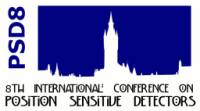Description
Pixel Detectors for Charged Particles
Norbert Wermes
(Physikalisches Institut)
05/09/2008, 09:00
Pixel Detectors for Charged Particles
Keynote talk
Pixel Detectors as the current technology of choice for the innermost
vertex detection have now reached a stage where large detectors have
been built for the LHC experiments and a new era of developments,
both for hybrid and for monolithic and semi-monolithic pixel
detectors is in full swing. This is largely driven by the
requirements of the Super-LHC and by collider experiments which...
Dr
Devis Contarato
(Lawrence Berkeley National Laboratory)
05/09/2008, 09:40
Pixel Detectors for Charged Particles
Oral Contribution
A monolithic pixel sensor has been design and fabricated in a novel deep-submicron 0.15 micron Silicon-On-Insulator (SOI) CMOS technology. This combines a thin layer of CMOS electronics isolated from a high-resistivity silicon substrate that can be depleted as in standard reversely-biased silicon detectors. The first prototype chip features arrays of analog and digital pixels of 10 micrometer...
Dr
Peter Kodys
(Charles University)
05/09/2008, 10:00
Pixel Detectors for Charged Particles
Oral Contribution
A new generation of track detectors for high energy physics are being designed for track recognition with submicron precision. Pixel detectors with micron resolution are a basic pre-requisite of such designs. With such precise detectors, however, the determination of spatial resolution becomes complicated because both multiple scattering and intrinsic detector errors contribute equally...
Dr
Gianluca Traversi
(University of Bergamo)
05/09/2008, 10:20
Pixel Detectors for Charged Particles
Oral Contribution
This work aims at discussing the design criteria and the characterization results relevant to a novel kind of monolithic active pixel sensors (MAPS) in deep submicron CMOS technology (130nm minimum feature size) for vertexing applications at the ILC. Compared to other CMOS MAPS, such devices implement pixel-level data sparsification and time stamping, with similar functionalities as in hybrid...
Dr
Freya Blekman
(Cornell University)
05/09/2008, 11:30
Pixel Detectors for Charged Particles
Oral Contribution
The CMS Pixel Detector consists of three barrel layers closed by two forward/backward disks on each side of the interaction region, and provides a crucial contribution to pattern recognition, primary and secondary vertices reconstruction, as well as heavy flavour tagging. The sensors are n-on-n, with n+ implants on n bulk silicon, and a cell size of 100x150 um2. The Lorentz drift of electrons...
Dr
Anna Bergamaschi
05/09/2008, 11:50
Pixel Detectors for Charged Particles
Oral Contribution
The MYTHEN detector is a silicon microstrip detector with single photon counting readout developed powder diffraction experiments at the Swiss Light Source. A one dimensional 30k channels system covering 120 degrees has been installed at the Material Science beamline and is being used for users operation since the end of 2007. Due to its massively parallel detection of X-rays and fast readout,...
Dr
David Cussans
(University of Bristol)
05/09/2008, 12:10
Pixel Detectors for Charged Particles
Oral Contribution
The ISIS (In-Situ charge storage Imaging Sensor) is a monolithic active pixel sensor with memory cells in each pixel. The memory cells are implemented as a CCD register. The device is a "burst camera" with charge being clocked simultaneously into the registers in each pixel. This makes the ISIS an excellent sensor for the ILC vertex detector for various reasons. The sensors can be made very...

